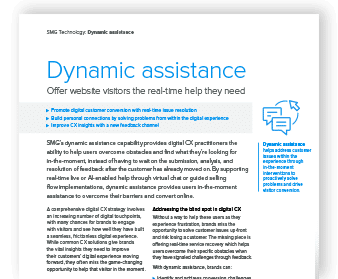Future-Proofing Your Digital Customer Experience Strategy
Published on Jun 08, 2022

With 1 in 3 online shoppers willing to take their business elsewhere after one bad experience, you can’t afford to have less-than-stellar digital touchpoints. But digital is just one piece of the puzzle, and if you’re not incorporating your digital customer experience strategy with feedback from other channels, you’re delivering fragmented experiences and missing out on conversion opportunities.
Brands must offer a frictionless cross-channel experience to meet the expectations of today’s consumer. If your CX data is siloed across multiple channels and platforms, meeting customer expectations will prove difficult, if not impossible.
So how can you give existing and potential customers the digital experience they expect—and deserve?
This blog shows how an integrated experience management (XM) strategy helps brands enhance the digital experience for consumers and earn their business in a sea of competitors.
Combine active and passive feedback to crowdsource your UX improvement areas
Every consumer is different—and so is their feedback. Some shoppers don’t realize they have anything to say until they’re asked about their experience. Others are eager to let you know what they’re thinking, whether you give them a designated outlet or not.
Actionable, business-changing insights come from a solid customer experience program with a combination of feedback provided by both active and passive channels—which is why you need to make both options available across your digital touchpoints.
Active feedback
Intuitive site-intercept surveys nudge consumers for feedback during various stages of the purchasing or booking process. You can decide which pages or specific behaviors trigger the survey, giving them the opportunity to measure discrete, isolated experiences. By configuring survey invitation criteria to capture feedback at critical points in the digital journey, you can surface more targeted insights and design a user experience optimized for conversion at each step in the purchase decision funnel.
Passive feedback
An always-on feedback button gives customers the opportunity to express how they feel about your site, your products, and their experience without a prompt. Maybe it’s a loyal, repeat customer mourning a discontinued product—or a first-time user hitting a roadblock while navigating your app. Whether it’s positive or negative, passive feedback goes the extra mile to answer the questions you hadn’t thought to ask.
Dynamic assistance
An optimal digital customer experience strategy includes right now problem solving—empowering brands to address customer pain points as they happen along the digital customer journey. With dynamic assistance, brands can employ:
- Virtual chat | Point users from the feedback button to virtual live chat for help, via either people-based assistance or AI assistance driven by logic-based rules
- Guided selling | Dynamic guided selling flows support product discovery and help users define what they’re looking for based on their specific needs
These in-the-moment interventions proactively solve problems and drive visitor conversion—helping every customer experience be a positive one, even when things don’t go quite right.

Offer website users the real-time help they need
Identify conversion opportunities with non-purchaser data
As e-commerce gets increasingly competitive, a user-friendly website can be the difference between a brand loyalist making a repeat purchase and a frustrated, lapsed customer turning to your competitor’s site. In fact, with the average abandonment rate at nearly 70%, e-commerce sites could be losing up to $3 billion a year.
To fully understand what makes users ditch your digital touchpoints, implement digital tools like:
Case management
Address user issues to earn back their trust. Manage problem resolution workflows through your integrated XM platform to close the loop on customer complaints and prevent repeat problems.
Session replay
See your digital touchpoints through the eyes of a shopper. Link recorded sessions of the user experience to survey results to help UX teams visualize and resolve points of friction.
Cart abandonment surveys
Were users turned off by shipping costs, delivery timelines, or account creation? Capture non-purchaser feedback to understand what went wrong and why shoppers chose to leave products behind.
Bridge the gap between in-store and online satisfaction
The digital experience and store experience aren’t often siloed—most customer interactions with your brand are a hybrid retail experience (e.g., BOPIS, curbside pickup, in-store, "researching/window shopping" via mobile). And if those experiences don’t line up or provide the same level of service, your customers will notice.
An integrated CX platform that shows digital and in-store data side-by-side provides the insights needed to bridge the satisfaction gap, and helps you:
Discover what influences channel preferences
Are guests using your app to avoid the drive-thru before work? Do customers shop online for large furniture, but in-store for accent pieces? An omnichannel approach answers these important questions and details what drives shoppers to each channel during their purchasing journey.
Identify common themes in customer feedback
Did both online and in-store guests mention payment issues in their feedback? Multisource text analytics can decipher recurring product mentions, trends, and sentiment across touchpoints to identify emerging systemic issues—and triggered alerts can help you resolve problems as they arise.
Personalize their experience by merging purchase data
Use what your brand already knows about customers to enhance their omnichannel experience. Base rewards off favorite menu items, automatically suggest the fitness instructor they book most frequently, or add a personalized “Recommended for You” section to your homepage.
Leverage journey analytics to drive satisfaction across touchpoints
Customer journey mapping can help you capture key touchpoints, enabling you to optimize the digital experience at crucial moments—from awareness and intent through acquisition and loyalty. And with aggregated data from all channels streamlined into a single interface for real-time, cross-channel analysis and visualization of your customer journey analytics, you can create go-forward journey management strategies to improve customer experiences + future-proof your business.
Add depth to digital data with DIY feedback
Sometimes, you plan for increased traffic—special promotions attract swarms of customers, both new and repeat. Other times, it’s more unexpected, leaving you confused by the uptick. That’s where self-service surveys come into play.
With the right self-serve strategy, technology, and support, organizations have more control and agility over how they engage with consumers—creating smarter touchpoints, more relevant interactions, and richer insights.
With intuitive DIY survey design capabilities, you can:
- Edit questions on-the-fly or choose from a pre-approved question bank
- Hyper-target your invitation criteria—triggering invites based on time on site, # of visits, # of clicks, pages visited, or a combination
- Build logic paths to prompt drill-down questions based on prior responses
- Take an iterative approach to testing + assessing conversion strategy tactics
Ensure your XM partner provides all the levers + knobs you need to fully control your digital feedback engagements with confidence.
Build an enterprise-level strategy with a holistic approach to CX
Advanced feedback collection, integrated reporting, and DIY survey capabilities are crucial to a modern digital XM program—but the high-tech platforms that offer these capabilities can be overwhelming without guidance. Aggregating all your channel data into one platform is a great place to start, but it still takes a lot of brainpower to put those datasets into dialogue that leads to business-changing results.
When you pair digital platforms with professional services and a dedicated team of CX pros, crucial insights are never out of reach. By choosing an XM partner that can support measurement strategies across all touchpoints, brands are more likely to benefit from:
- Consistent survey scales + key performance metrics across listening posts
- Sampling methodologies that avoid over-surveying customers
- Analysis + insight support that covers the end-to-end customer journey
A collaborative account management team should understand your program goals and empower you to reach them by offloading daily administrative tasks, leveraging best practices, and building and maintaining a best-in-class program.
One experience management platform charts direct paths to improvement
Attempting to oversee digital CX with a single-channel solution adds yet another silo to your data and another program to your XM stack. The easiest way to interpret and act on consumer behavior across all touchpoints? A multi-channel XM platform.
SMG’s digital experience offering helps brands capture solicited and unsolicited feedback across an increasing number of digital touchpoints—customers often use the most readily available feedback option when issues arise.
Additionally, dynamic assistance allows brands to engage customers within the feedback channel, provide real-time service recovery, and turn a negative experience into a positive interaction.
SMG’s dynamic assistance integrates conversational AI and guided selling to identify customer needs up front so brands can close the loop during the visit and capture actionable customer feedback—making use of powerful integrations with Creative Virtual and Conversity.
By combining dynamic assistance insights with feedback data collected across touchpoints, we provide brands a more holistic view of the digital experience, insights that improve conversion, and increased program ROI.
Related articles

How Brands Can Create Empathetic Customer Experiences In the New Normal
As of last June, 81% of Americans owned a smartphone. In the throes of this convenience revolution—as more consumers turn to their phones for research and to make purchases—the pressure for brands to

Getting Experience Data to Stay Customer Centric with Contactless Service
As of last June, 81% of Americans owned a smartphone. In the throes of this convenience revolution—as more consumers turn to their phones for research and to make purchases—the pressure for brands to

Consumer Behavior Trends: Spending Habits in 2022
As of last June, 81% of Americans owned a smartphone. In the throes of this convenience revolution—as more consumers turn to their phones for research and to make purchases—the pressure for brands to